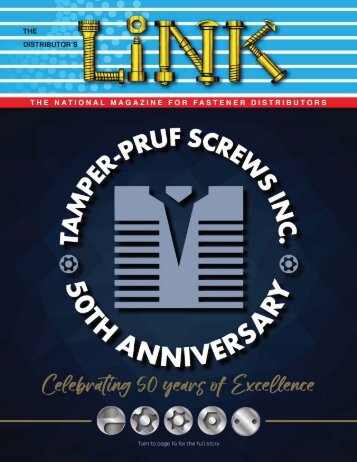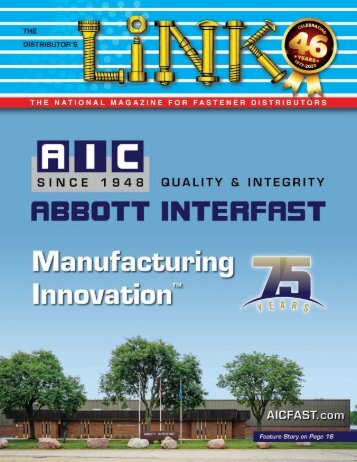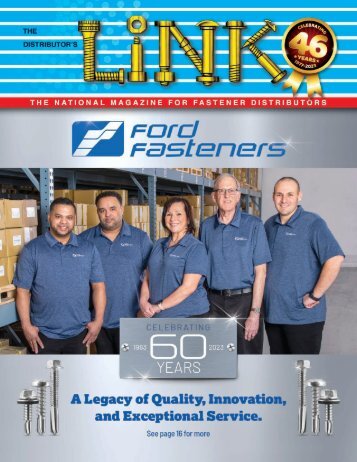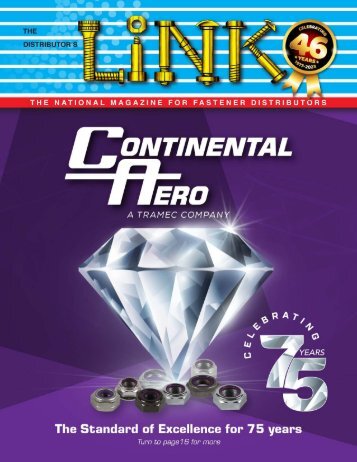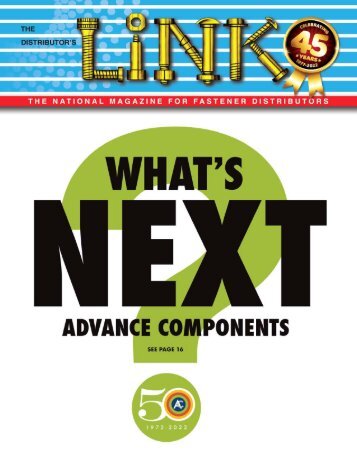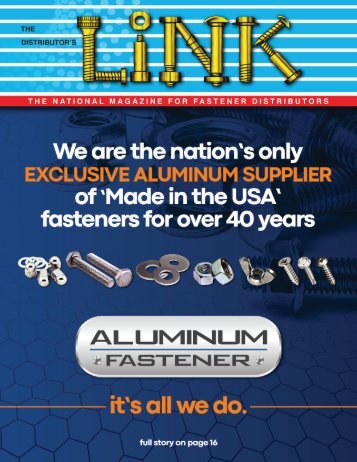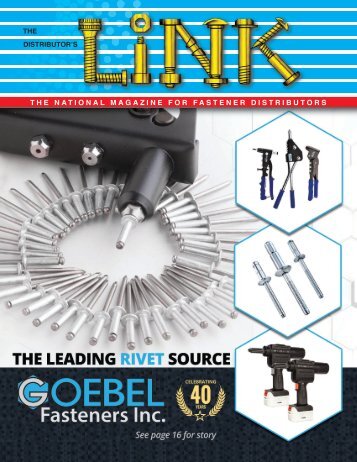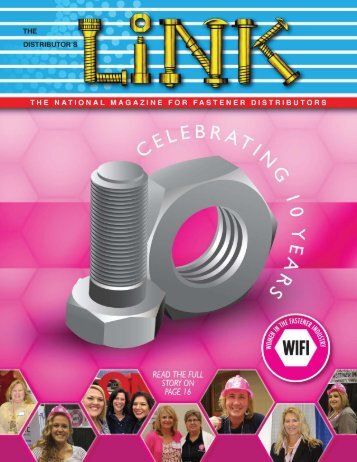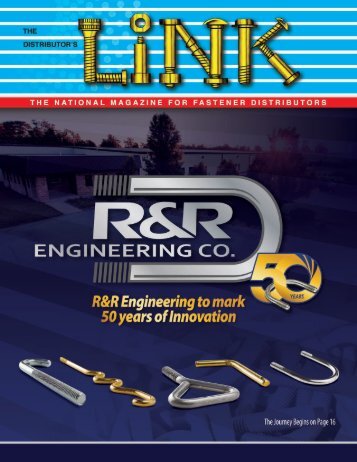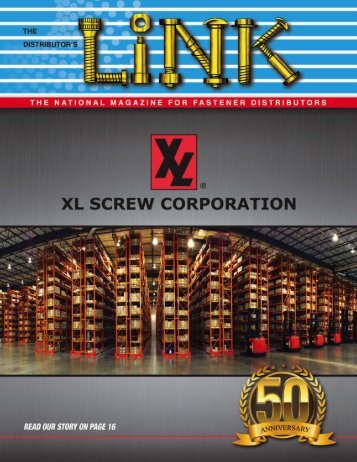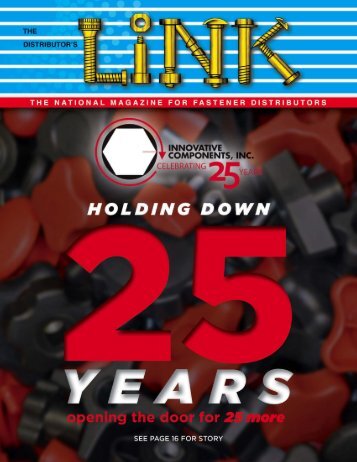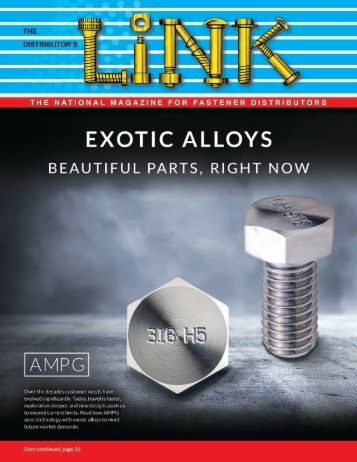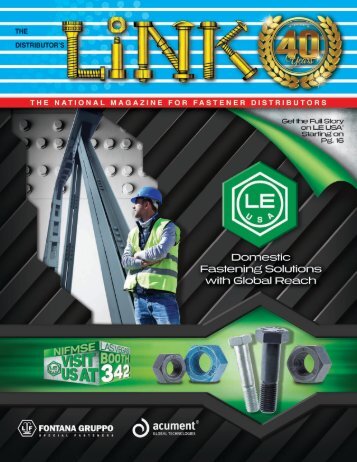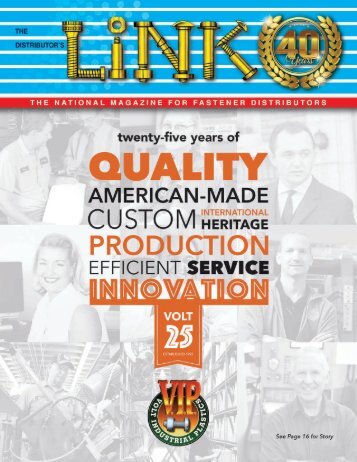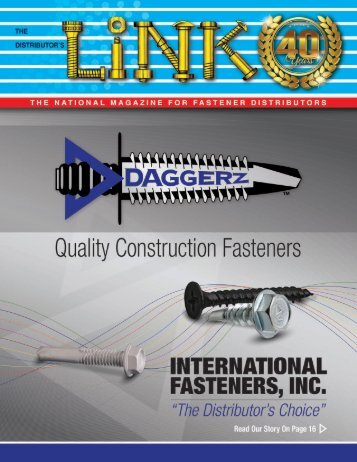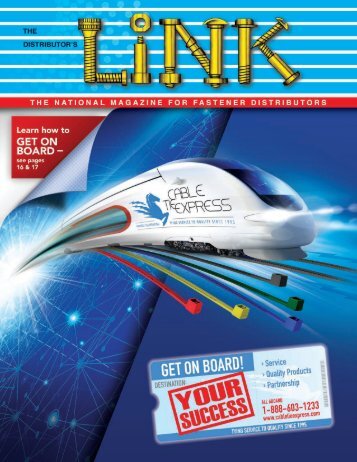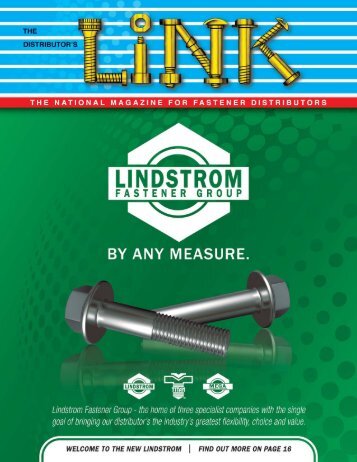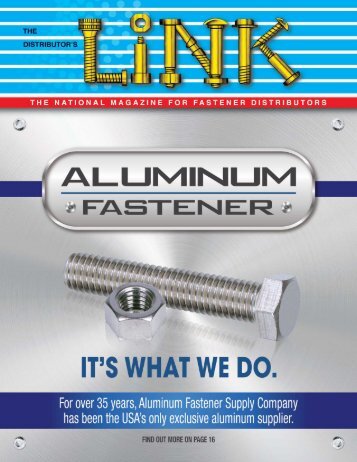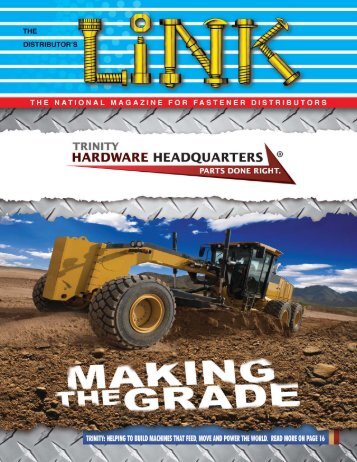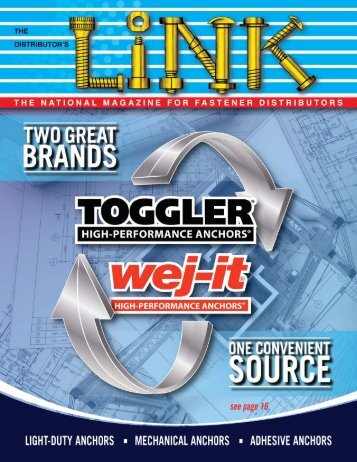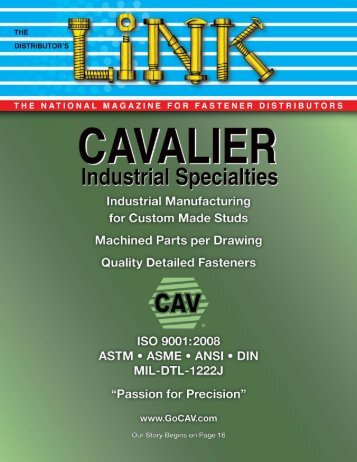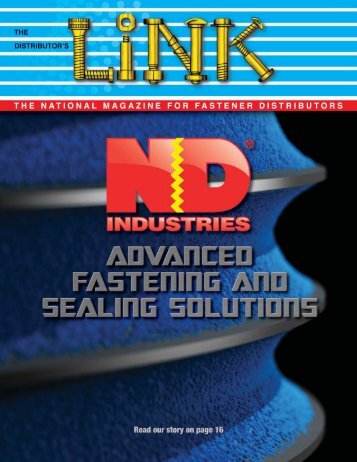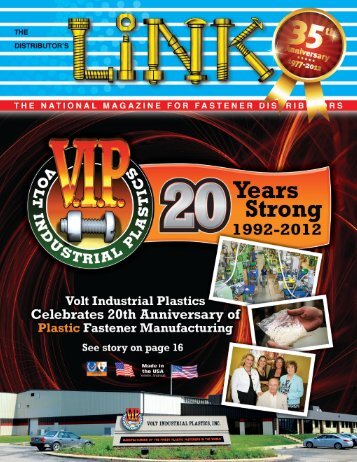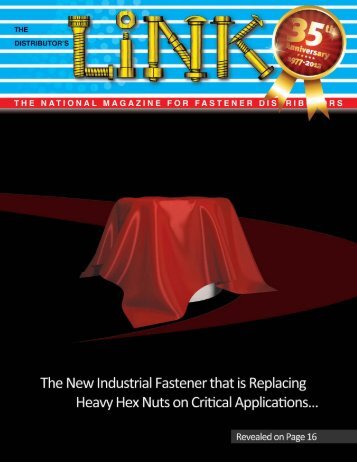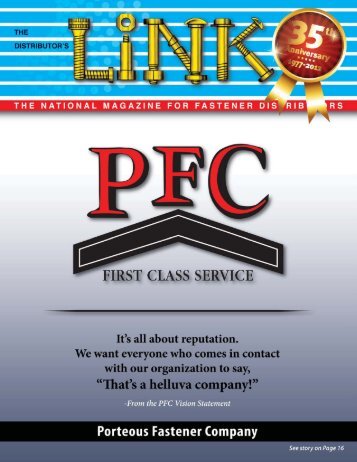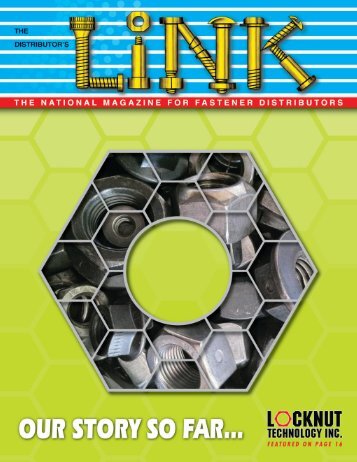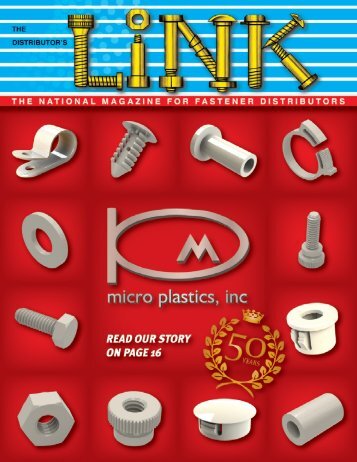FALL 2017
- Text
- Fastener
- Fasteners
- Products
- Manufacturing
- Bolt
- Torque
- Industrial
- Distributors
- Screws
- Distributor
78 THE DISTRIBUTOR’S
78 THE DISTRIBUTOR’S LINK SPIROL INTERNATIONAL CORP. 30 Rock Avenue, Danielson, CT 06239 TEL 1-860-774-8571 FAX 1-860-774-2048 EMAIL info@spirol.com WEB www.spirol.com LIGHT DUTY COILED SPRING PIN USAGE IN ASSEMBLIES WITH SOFT MATERIALS by Christie L. Jones, Market Development Manager In recent years, the tendency throughout the industry has been to explore the use of new materials in order to reduce weight and process cost, or to provide solutions where more traditional materials such as steel, machined components or castings would not perform as well. Under those considerations, the use of plastic, aluminium and soft alloys has seen an exponential increase, and nothing seems to indicate that this trend is going to stop. On the contrary, as plastics and moulding processes continue to advance, more and more applications that were traditionally made in steel are being reviewed to overcome the issues that prevented the use of these lighter, softer materials that provide equal or even better performance. We can currently find numerous plastic components being used in demanding situations such as high temperature, high strength and chemical resistant applications. However, although the main component receives significant design attention and consideration, the mating components and the fastening method are habitually neglected until the end of the project. Also, it is routinely assumed that parts and design concepts that previously worked in steel will work with the softer alloys and plastics. When it comes to pinning applications in new materials, it is frequently a situation of going for the cheapest option and what is known in the industry. In many cases this is the (heavy duty) Slotted Pin per ISO 8752 (also known as the roll pin), which has been around for many years, developed from the old DIN 1481 standard. This pin was designed long before the advancements in production techniques and materials made lightweight / high-volume production feasible. The ISO 8752 Slotted Pin can and does, in fact, create significant assembly and quality issues in these new materials. Its thick wall, combined with an out-of-round or horse-shoe shape, does not provide the required flexibility for its use in relatively soft materials - often transferring the load from the pin to the wall of the host assembly, thereby damaging the hole, and resulting in premature assembly failure. In an attempt to reduce the disadvantages associated with the heavy duty Slotted Pin per ISO 8752, a light duty Slotted Spring Pin per ISO 13337 was designed. The main difference is the thickness of the pin wall. A thinner wall means increased flexibility, but also reduced shear strength, while other important issues remain unresolved. In fact, the thinner wall in and of itself creates new additional limitations with respect to fatigue resistance. Light duty (ISO 13337) Slotted Spring Pins, similar to the more common heavy duty Slotted Pin (per ISO 8752), present a horse-shoe shape cross-section which will, in many instances, create skiving during insertion into the hole. Coupled with that, the expanded diameter of the pin in relation to the size of the hole has the effect of creating a pin with a very wide slot. The result is a pin with an insertion force, and subsequent radial pressure against the wall of the hole, that will still be too high for most soft material applications, especially where holes are close to the edge of the component. TECHNICAL ARTICLE CONTINUED ON PAGE 178
- Page 6 and 7:
in thefall2017issueof 6 DISTRIBUTOR
- Page 8:
6 THE DISTRIBUTOR’S LINK Innovati
- Page 12:
10 THE DISTRIBUTOR’S LINK NORTH E
- Page 16:
14 THE DISTRIBUTOR’S LINK Laurenc
- Page 28: 26 THE DISTRIBUTOR’S LINK Guy Ave
- Page 32: 30 THE DISTRIBUTOR’S LINK Steven
- Page 36 and 37: 34 THE DISTRIBUTOR’S LINK Dennis
- Page 38: 36 THE DISTRIBUTOR’S LINK CARVER
- Page 44 and 45: 42 THE DISTRIBUTOR’S LINK Michael
- Page 46: 44 THE DISTRIBUTOR’S LINK SPECIAL
- Page 50: 48 THE DISTRIBUTOR’S LINK MOUNTZ
- Page 54 and 55: 52 THE DISTRIBUTOR’S LINK The INF
- Page 56: 54 THE DISTRIBUTOR’S LINK NOR-CAL
- Page 61 and 62: THE DISTRIBUTOR’S LINK 59
- Page 66 and 67: 64 THE DISTRIBUTOR’S LINK Anthony
- Page 68: 66 THE DISTRIBUTOR’S LINK NATIONA
- Page 71 and 72: RHS STAINLESS THE DISTRIBUTOR’S L
- Page 74 and 75: 72 THE DISTRIBUTOR’S LINK Robert
- Page 76 and 77: 74 THE DISTRIBUTOR’S LINK GLOBALF
- Page 78: 76 THE DISTRIBUTOR’S LINK BEACON
- Page 84: 82 THE DISTRIBUTOR’S LINK SENCO B
- Page 88 and 89: 86 THE DISTRIBUTOR’S LINK SPEEDY
- Page 90: 88 THE DISTRIBUTOR’S LINK Jo Morr
- Page 94: 92 THE DISTRIBUTOR’S LINK THE BRA
- Page 98 and 99: 96 THE DISTRIBUTOR’S LINK ROTOR C
- Page 100: 98 THE DISTRIBUTOR’S LINK COLOC M
- Page 103 and 104: AVK INDUSTRIAL PRODUCTS THE DISTRIB
- Page 106: 104 THE DISTRIBUTOR’S LINK In an
- Page 110: 108 THE DISTRIBUTOR’S LINK ZaGO M
- Page 114 and 115: 112 THE DISTRIBUTOR’S LINK SOUTHE
- Page 116: 114 THE DISTRIBUTOR’S LINK FASTEN
- Page 120: PAC-WEST 2017 FALL CONFERENCE WHIST
- Page 123 and 124: LIPPINCOTT SUPPLY CO. INC. THE DIST
- Page 125 and 126: THE DISTRIBUTOR’S LINK 123
- Page 128 and 129: 126 THE DISTRIBUTOR’S LINK LAUREN
- Page 130:
128 THE DISTRIBUTOR’S LINK RICHAR
- Page 133:
GOEBEL FASTENERS INC. QUALITY IS EV
- Page 136:
134 THE DISTRIBUTOR’S LINK FASTEN
- Page 139 and 140:
THE DISTRIBUTOR’S LINK 137
- Page 142 and 143:
140 THE DISTRIBUTOR’S LINK METROP
- Page 144 and 145:
142 THE DISTRIBUTOR’S LINK DENNIS
- Page 146 and 147:
144 THE DISTRIBUTOR’S LINK CARVER
- Page 148:
146 THE DISTRIBUTOR’S LINK MICHAE
- Page 152 and 153:
150 THE DISTRIBUTOR’S LINK MOUNTZ
- Page 154 and 155:
152 THE DISTRIBUTOR’S LINK CRAFTE
- Page 156 and 157:
154 THE DISTRIBUTOR’S LINK NOR-CA
- Page 158:
156 THE DISTRIBUTOR’S LINK SENCO
- Page 161 and 162:
THE DISTRIBUTOR’S LINK 159 BRIGHT
- Page 164 and 165:
fastenerlinks THE DEFINITIVE WEB DI
- Page 166 and 167:
fastenerlinks BRINGING YOU THE FAST
- Page 168 and 169:
fastenerlinks BRINGING YOU THE FAST
- Page 170 and 171:
fastenerlinks BAY SUPPLY A DIVISION
- Page 172 and 173:
170 THE DISTRIBUTOR’S LINK JIM TR
- Page 174:
172 THE DISTRIBUTOR’S LINK ROBERT
- Page 177 and 178:
THE DISTRIBUTOR’S LINK 175 EFC In
- Page 180 and 181:
178 THE DISTRIBUTOR’S LINK SPIROL
- Page 182 and 183:
180 THE DISTRIBUTOR’S LINK DISTRI
- Page 184 and 185:
182 THE DISTRIBUTOR’S LINK SPIROL
- Page 186 and 187:
184 THE DISTRIBUTOR’S LINK G.L. H
- Page 188 and 189:
186 THE DISTRIBUTOR’S LINK BENGT
- Page 190:
188 THE DISTRIBUTOR’S LINK LAUREN
- Page 193 and 194:
THE DISTRIBUTOR’S LINK 191
- Page 195 and 196:
THE DISTRIBUTOR’S LINK 193 The Ad
- Page 198 and 199:
196 THE DISTRIBUTOR’S LINK CARVER
- Page 200 and 201:
198 THE DISTRIBUTOR’S LINK NIFMSE
- Page 202 and 203:
200 THE DISTRIBUTOR’S LINK MICHAE
- Page 204 and 205:
202 THE DISTRIBUTOR’S LINK MOUNTZ
- Page 206:
204 THE DISTRIBUTOR’S LINK NATION
- Page 209 and 210:
THE DISTRIBUTOR’S LINK 207 MAFDA
- Page 212 and 213:
210 THE DISTRIBUTOR’S LINK LAUREN
- Page 214:
212 THE DISTRIBUTOR’S LINK LAUREN
- Page 217 and 218:
MAFDA 14th ANNUAL GOLF & SHOLARSHIP
- Page 219 and 220:
THE DISTRIBUTOR’S LINK 217
- Page 222:
220 THE DISTRIBUTOR’S LINK ROBERT
- Page 225 and 226:
THE DISTRIBUTOR’S LINK 223
- Page 228:
226 THE DISTRIBUTOR’S LINK DDI Sy
- Page 232:
230 THE DISTRIBUTOR’S LINK MID-WE
- Page 236:
advertisers index C CHICAGO HARDWAR
- Page 240:
advertisers index M MAR-BRO MANUFAC
Inappropriate
Loading...
Mail this publication
Loading...
Embed
Loading...
|
SHARE A PAGE FROM THIS MAGAZINE OPTION 1: Click on the share tab above, or OPTION 2: Click on the icon (far right of toolbar) and then click on the icon (far right of toolbar) and then click on the  icon (top right of the page). icon (top right of the page).
|
View Archives
Copyright © Distributor's Link, Inc. All Rights Reserved | Privacy Policy







